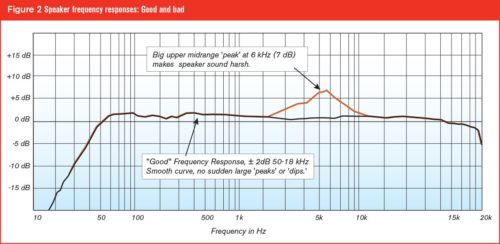The back of your headphone’s box or instruction manual is covered in specifications designed to assist audiophiles and audio junkies in selecting the right pair of cans – just like anything else you shop for. But unlike that carton of milk or bag of cookies, the specs on the packaging aren’t that easy to understand. For that reason, we will help you with one of the essentials – understanding headphone frequency response.
Understanding Headphone Frequency Response
Headphone frequency response is the range of bass, mids, and treble measured in Hertz (Hz).
Low Bass (LFE range – Low Frequency Effects) 10Hz – 50Hz
Musical Bass (bass guitar, kick drum, orchestral bass) 50Hz – 100Hz
Upper Bass (male vocals & directional bass) 100Hz – 200Hz
Midrange (most instruments, vocal dialogue, on-screen effects) 200Hz – 4000Hz
Treble (cymbals, triangles, hissing “s” in speech) 4,000Hz – 20,000Hz
c/o Alesis
The range associated with your headphone describes the range in which the drivers are able to provide clear, distortion-free audio to your ears. The range most commonly found on your headphone specs sheet is 20Hz to 20,000Hz. The first number indicates the bass while the second number indicates the treble. This range is essentially the standard because it represents the normal audible musical frequency range heard by humans. There are some headphones that extend further, reaching 10Hz to 35,000Hz, for example, but humans don’t necessarily hear frequencies past 20Hz. Humans feel them. It is important to note that an extended frequency response range is not indicative of the headphone’s sound quality.
Understanding Headphone Frequency Response Graphs

So, now that you understand what a headphone frequency response is, let’s go over understanding headphone frequency response graphs. Often times reviewers use graphs to illustrate how great or poor a headphone is. You can better understand how well the headphone may perform by understanding how to read the graph. Again, this is not the only indication of how good a headphone is.
In theory, the line on a frequency response graph should be relatively flat line since the range demonstrate the headphone’s ability to reproduce all frequencies equally. A “natural sounding” headphone is said to be slightly higher in the bass between 40Hz and 500Hz. That’s where bass instruments and deep male vocals live, remember?!
If the line on the graph is slightly higher on the left side that means the headphones produce sound with more bass response. If the right side of the graph is higher than the left, that means the headphones have a greater response in the mids, highs, and treble. That headset would be considered bright.
As Headphone.com explains, headphones have to compensate for the drivers being so close to the ear in the highs, so the highs are “rolled-off” and illustrated by a gradual sloping flat line from 1kHz to about 8-10dB down to 20kHz. In addition, small spikes at higher frequencies are normal as that is due to reflection cancellations in the folds and ridges in the outer part of the ear. But, sharp spikes in frequency (peaks and deep valleys) over 3,000Hz or so are indications of when the headphone sounds harsh.
Other Specs to Consider
As I’ve been mentioning throughout this article, headphone frequency response is not the only factor to consider when looking for a headphone. You’ll also want to consider the impedance, sensitivity, sound pressure level, and more. If you have any questions let us know down below.
MAJORHIFI may receive commissions from retail offers.








